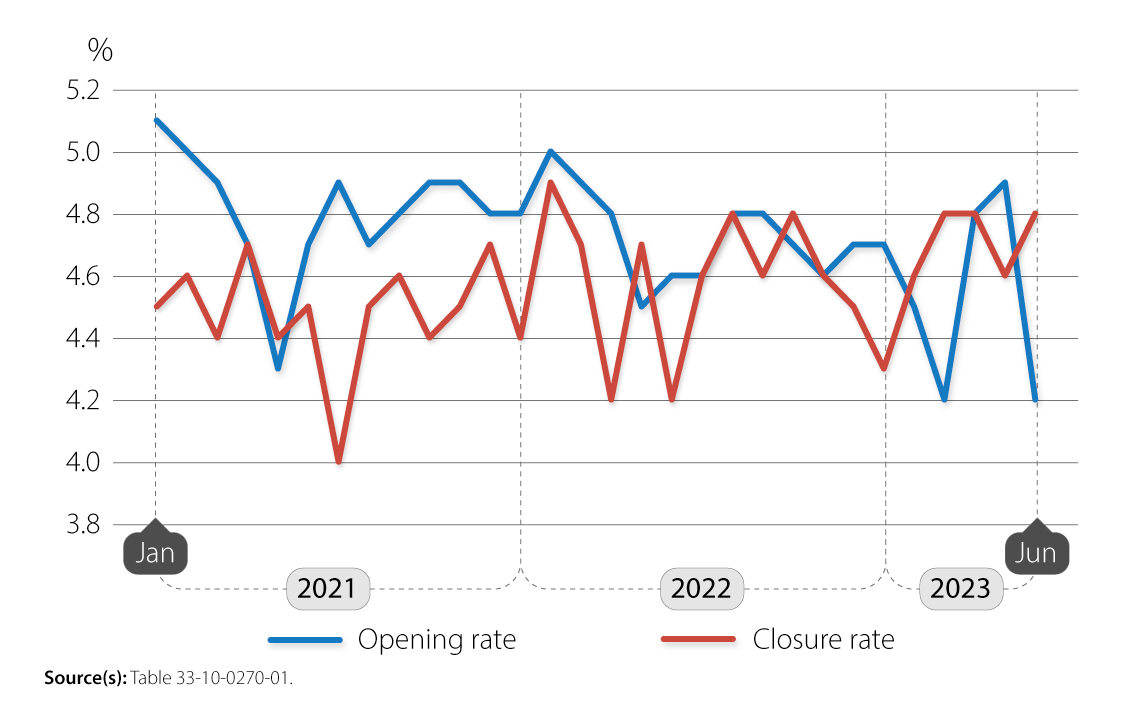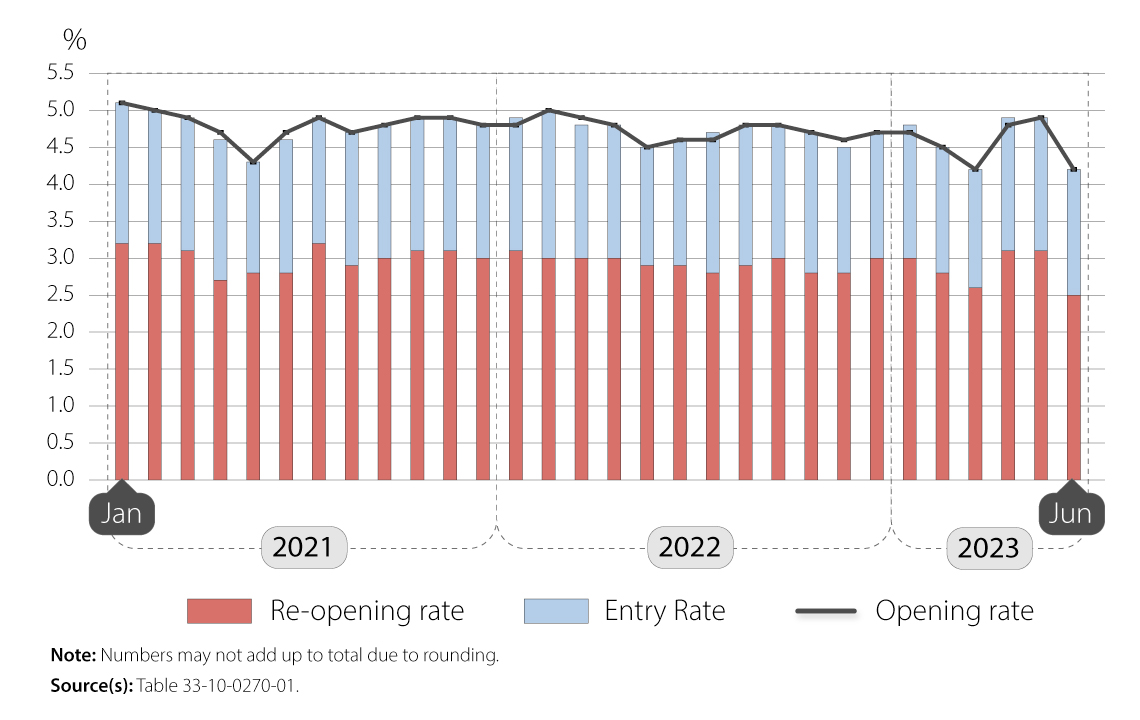
The business opening rate decreased from 4.9% in May to 4.2% in June, its lowest level since March 2020. The business closure rate grew 0.2 percentage points to 4.8% in June 2023, following a similar decline in May. The business opening rate was 0.5 percentage points below its pre-COVID-19 pandemic level in June, while the closure rate was 0.2 percentage points above its pre-pandemic level.
Chart 1: Monthly business openings and closures as a percentage of active businesses, business sector, January 2021 to June 2023, seasonally adjusted data

Description - Chart 1: Monthly business openings and closures as a percentage of active businesses, business sector, January 2021 to June 2023, seasonally adjusted data
The title of the chart is " Monthly business openings and closures as a percentage of active businesses, business sector, January 2021 to June 2023, seasonally adjusted data"
This is a line chart.
The vertical axis shows the rates of openings and closures, from 3.8% to 5.2%, by increments of 0.2%.
The horizontal axis shows years from January 2021 to June 2023 by increments of year.
There are two series in this chart.
The first series is Opening rate. The lowest points in this line are 4.2% in March and June 2023, and the highest point in this line is 5.1% in January 2021.
The second series is Closure rate. The lowest point in this line is 4% in July 2021, and the highest point in this line is 4.9% in February 2022.
Source(s): Statistics Canada Table 33-10-0270-01
As there were fewer openings than closures, the number of active businesses shrunk 0.8% or by 7,327 in June, following a 0.5% increase in May. Real gross domestic product also fell in June (- 0.2%), following an equivalent rise the previous month.
The decrease in the business opening rate in June was largely driven by the re-opening rate which dropped from 3.1% to 2.5%, its lowest level since December 2015. The entry rate edged down 0.1 percentage points to 1.7% in June. The re-opening rate was 0.4 percentage points below its 2015-to-2019 historical average, whereas the entry rate was just below its historical average of 1.8%.
Chart 2: Business opening rate and its components, business sector, January 2021 to June 2023, seasonally adjusted data

Description - Chart 2: Business opening rate and its components, business sector, January 2021 to June 2023, seasonally adjusted data
The title of the chart is " Business opening rate and its components, business sector, January 2021 to June 2023, seasonally adjusted data"
This is a vertical stacked bar chart with line .
The vertical axis represents the % rate.
The vertical axis starts at 0 and goes to 5.5%, with increments of 0.5%.
The horizontal axis represents the months and year and goes from January 2021 to June 2023.
There are three series. The first series represents the re-opening rate. The second series represents the entry rate. The third series represents the opening rate.
At period January 2021, the first series is at 3.2%, the second series is at 1.9% and the third series is at 5.1%.
At period February 2021, the first series is at 3.2%, the second series is at 1.8% and the third series is at 5.0%.
At period March 2021, the first series is at 3.1%, the second series is at 1.8% and the third series is at 4.9%.
At period April 2021, the first series is at 2.7%, the second series is at 1.9% and the third series is at 4.7%.
At period May 2021, the first series is at 2.8%, the second series is at 1.5% and the third series is at 4.3%.
At period June 2021, the first series is at 2.8%, the second series is at 1.8% and the third series is at 4.7%.
At period July 2021, the first series is at 3.2%, the second series is at 1.7% and the third series is at 4.9%.
At period August 2021, the first series is at 2.9%, the second series is at 1.8% and the third series is at 4.7%.
At period September 2021, the first series is at 3.0%, the second series is at 1.8% and the third series is at 4.8%.
At period October 2021, the first series is at 3.1%, the second series is at 1.8% and the third series is at 4.9%.
At period November 2021, the first series is at 3.1%, the second series is at 1.8% and the third series is at 4.9%.
At period December 2021, the first series is at 3.0%, the second series is at 1.8% and the third series is at 4.8%.
At period January 2022, the first series is at 3.1%, the second series is at 1.8% and the third series is at 4.8%.
At period February 2022, the first series is at 3.0%, the second series is at 2.0% and the third series is at 5.0%.
At period March 2022, the first series is at 3.0%, the second series is at 1.8% and the third series is at 4.9%.
At period April 2022, the first series is at 3.0%, the second series is at 1.8% and the third series is at 4.8%.
At period May 2022, the first series is at 2.9%, the second series is at 1.6% and the third series is at 4.5%.
At period June 2022, the first series is at 2.9%, the second series is at 1.7% and the third series is at 4.6%.
At period July 2022, the first series is at 2.8%, the second series is at 1.9% and the third series is at 4.6%.
At period August 2022, the first series is at 2.9%, the second series is at 1.9% and the third series is at 4.8%.
At period September 2022, the first series is at 3.0%, the second series is at 1.8% and the third series is at 4.8%.
At period October 2022, the first series is at 2.8%, the second series is at 1.9% and the third series is at 4.7%.
At period November 2022, the first series is at 2.8%, the second series is at 1.7% and the third series is at 4.6%.
At period December 2022, the first series is at 3.0%, the second series is at 1.7% and the third series is at 4.7%.
At period January 2023, the first series is at 3.0%, the second series is at 1.8% and the third series is at 4.7%.
At period February 2023, the first series is at 2.8%, the second series is at 1.7% and the third series is at 4.5%.
At period March 2023, the first series is at 2.6%, the second series is at 1.6% and the third series is at 4.2%.
At period April 2023, the first series is at 3.1%, the second series is at 1.8% and the third series is at 4.8%.
At period May 2023, the first series is at 3.1%, the second series is at 1.8% and the third series is at 4.9%.
At period June 2023, the first series is at 2.5%, the second series is at 1.7% and the third series is at 4.2%.
Note: Numbers may not add up to total due to rounding.
Source: Statistics Canada Table 33-10-0270-01
The decrease in the business opening rate in June was widespread across sectors. Transportation and warehousing (-895 openings; or -1.7 percentage points compared with the previous month) led the decline, followed by professional, scientific and technical services (-745; -0.6 percentage points). Construction (-0.6 percentage points) and health care and social assistance (-0.7 percentage points) both posted 701 fewer business openings.
Business insolvencies reach highest level since 2014 in the second quarter
The business closure rate rose in all sectors in June. The increase in the overall rate was mainly driven by construction (+674 closures; or +0.6 percentage points compared with one month earlier), retail trade (+581; +0.7 percentage points) and accommodation and food services (+429; +0.7 percentage points).
The construction, retail trade, and accommodation and food services sectors also reported the sharpest declines in the number of active businesses and the largest increases in business insolvencies in June 2023. In the second quarter, business insolvencies reached their highest level since 2014, mainly driven by these three sectors.
In the same quarter, businesses in accommodation and food services (68.4%) and retail trade (63.8%) were among the most likely to expect obstacles related to rising inflation which was the most common challenge expected by businesses.
The series on temporary business closures and exits (or "permanent closures") is now updated to include data up to December 2022
The exit rate grew from 1.7% in November to 1.9% in December 2022, slightly above its historical average of 1.7%. The exit rate edged up or remained relatively unchanged in all sectors in December.
The exit rate remained further away and higher than its historical average in transportation and warehousing (2.7% exit rate compared with 1.5% historical average), real estate and rental and leasing (2.4% compared with 1.9%) and professional, scientific and technical services (2.0% compared with 1.7%).
Related products
Data table
Previous release
Definitions, data sources and methods
StatsCAN app
Did you know you can read StatsCAN Plus articles and more on the StatsCAN app? If you’re already using the app, let us know what you think by leaving a review in the Apple App Store and Google Play.
Contact information
For more information, contact the Statistical Information Service (toll-free 1-800-263-1136; 514-283-8300; infostats@statcan.gc.ca) or Media Relations (statcan.mediahotline-ligneinfomedias.statcan@statcan.gc.ca).
